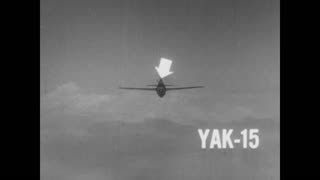Dating to 1951 and made by the Jam Handy Organization for the U.S. Navy, these three “Aircraft Recognition Soviet Jet Aircraft” were essential viewing for pilots, crew and anti-aircraft gunners during the Korean War. The first film profiles the Mig-15 and begins with motion picture images from Soviet propaganda films before using animation / composite shots that utilize a model and rear-screen projection (1:20). At (1:46) the narrator discussed the swept-back wings of the aircraft, which allowed it to achieve high transonic speeds. At (2:58) a side view of the aircraft is shown, and the narrator discusses the swept-back fin, high horizontal stabilizer, and forward canopy. At (4:10) the narrator discusses the aircraft’s armament. At (5:09) the model aircraft makes pursuit runs and demonstrates its high performance characteristics. The film ends with shots from an American gun camera of a Mig-15 being pursued and hit.
At (6:29) the Yak 15 Modified aircraft is profiled with images from Soviet propaganda films of the planes flying in formation. At (7:00), models and animation show the plane’s characteristics. At 10:50 the narrator says “There are lots of Yak-15s so get to know them now.”
At (11:14) the Mig-9 Aircraft is featured.
The MiG-9 was the first turbojet fighter developed by Mikoyan-Gurevich in the years immediately after World War II. It used reverse-engineered German BMW 003 engines. Categorized as a first-generation jet fighter, it suffered from persistent problems with engine flameouts when firing its guns at high altitudes due to gun gas ingestion. A number of different armament configurations were tested, but none solved the problem. Several different engines were evaluated, but none were flown, as the prototype of the MiG-15 promised superior performance.
A total of 610 aircraft were built, including prototypes, and they entered service in 1948 with the Soviet Air Forces. At least 372 were transferred to the People’s Liberation Army Air Force in 1950 to defend Chinese cities against air raids by the Nationalist Chinese and train the Chinese pilots in jet operations. The MiG-9 was quickly replaced by the MiG-15.
The MiG-15 was developed by Mikoyan-Gurevich and was one of the first successful jet fighters to incorporate swept wings. In aerial combat during the Korean War, it outclassed straight-winged jet day fighters, which were largely relegated to ground-attack roles. In response to the MiG-15’s appearance and in order to counter it, the United States Air Force rushed the North American F-86 Sabre to Korea.
The Yakovlev Yak-15 was a first-generation Soviet turbojet fighter developed by the Yakovlev design bureau (OKB) immediately after World War II. The main fuselage was that of Yakovlev Yak-3 piston-engine fighter modified to mount a reverse-engineered German Junkers Jumo 004 engine. . Although nominally a fighter, it was mainly used to qualify piston-engine-experienced pilots to fly jets.
Motion picture films don’t last forever; many have already been lost or destroyed. For almost two decades, we’ve worked to collect, scan and preserve the world as it was captured on 35mm, 16mm and 8mm movies — including home movies, industrial films, and other non-fiction. If you have endangered films you’d like to have scanned, or wish to donate celluloid to Periscope Film so that we can share them with the world, we’d love to hear from you. Contact us via the weblink below.
This film is part of the Periscope Film LLC archive, one of the largest historic military, transportation, and aviation stock footage collections in the USA. Entirely film backed, this material is available for licensing in 24p HD, 2k and 4k. For more information visit http://www.PeriscopeFilm.com


